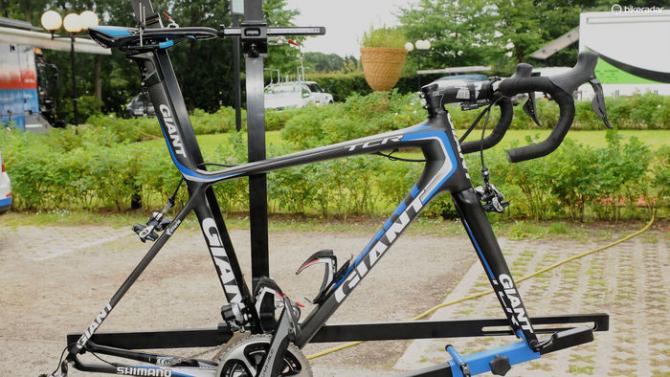Video: Inside the UCI time trial bike checks at the World Championships
Jigs, tolerances and Swiss engineering

The UCI's rules regarding legal positions for time trial bikes have caused great consternation over the years, with teams complaining that the jigs used to check bar length and saddle level and set back were inconsistent. There's nothing worse than showing up to the start ramp for a race only to be told your bike is not legal. So the UCI recruited some Swiss engineers to create a measuring device that can be easily transported to the World Championships and assess hundreds of bikes quickly and accurately.
The UCI commissaires' day begins early, with the measuring area being ready more than two hours ahead of time to allow mechanics a chance to examine the jigs if they so desire. Two hours before the start time, bikes begin rolling through for their first check. The first measurement will allow the mechanics to make any adjustments the riders need to be within the rules.
The jig breaks down to fit inside a special padded hard-shell case, and is assembled before the race in the cordoned off paddock near the start ramp. After it is assembled, the jig is calibrated by checking the angles and the measurements between the uprights. If the ground is not level, that is no matter, because the device that measures saddle angle is zeroed out with respect to the ground.
Every bike is set into the jig with two cone-shaped pegs fitting into the centre of the cranks at the bottom bracket so that all of the measurements are tied to the center of the bottom bracket. There are two sets of levers - one that measures saddle setback and one that measures bar extension length - that swing forward. If the levers clear the saddle nose and the bar extensions, the bike passes that criterion. Then the saddle angle is measured with a digital device that rests on the saddle.
Many of the juniors, who have less experience with UCI testing, had to make adjustments after the first check, while the elite men generally pass on the first check.
While Cyclingnews was there in Kings Dominion before the elite men's time trial, Stephen Cummings' Cervelo was put on the jig, and although the Briton is given an exception for being taller than 190cm, his bars were still too long and had to be taken back and brought in. The bikes are checked again 15 minutes before the rider's start time, and then are not allowed to leave the measuring paddock.
The jigs cost 3,500 Swiss Francs each, and are accurate to 1-2mm, but the UCI commissaires insist that the difference of one millimeter would never disqualify a bike. German rider Charlotte Becker was denied the start of the team time trial with her Hitec Products team on Sunday and told her team that the bar length was off by 1mm, but the UCI says this is impossible.
Get The Leadout Newsletter
The latest race content, interviews, features, reviews and expert buying guides, direct to your inbox!
Mark Barfield, the UCI's Technical Manager, says the teams and riders often push right up to the rule limits. "The rule is that the saddle should be flat, with a tolerance of 2.5 degrees, with a 0.5 degree margin of error. Often times teams assume that means three degrees is OK."

Laura Weislo has been with Cyclingnews since 2006 after making a switch from a career in science. As Managing Editor, she coordinates coverage for North American events and global news. As former elite-level road racer who dabbled in cyclo-cross and track, Laura has a passion for all three disciplines. When not working she likes to go camping and explore lesser traveled roads, paths and gravel tracks. Laura specialises in covering doping, anti-doping, UCI governance and performing data analysis.